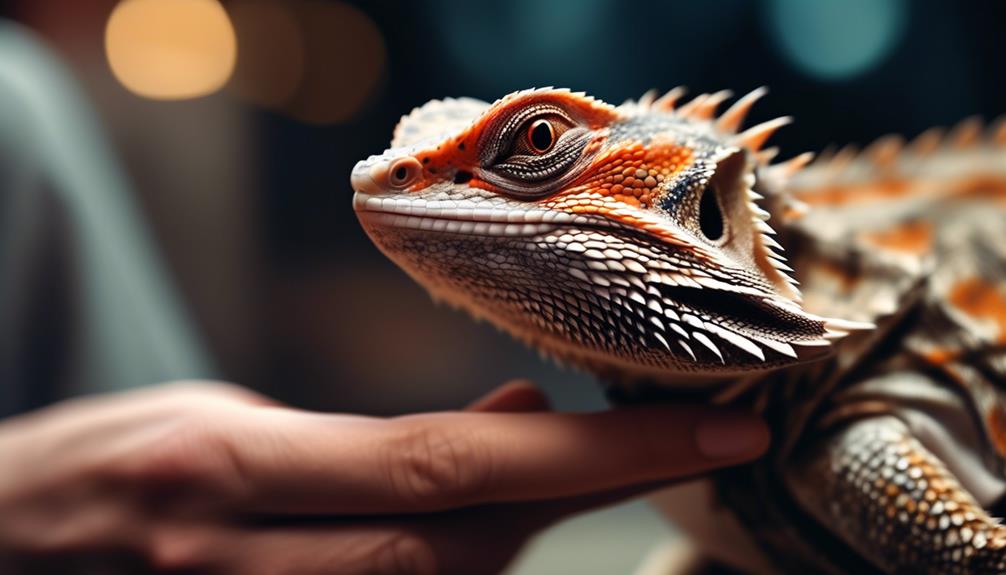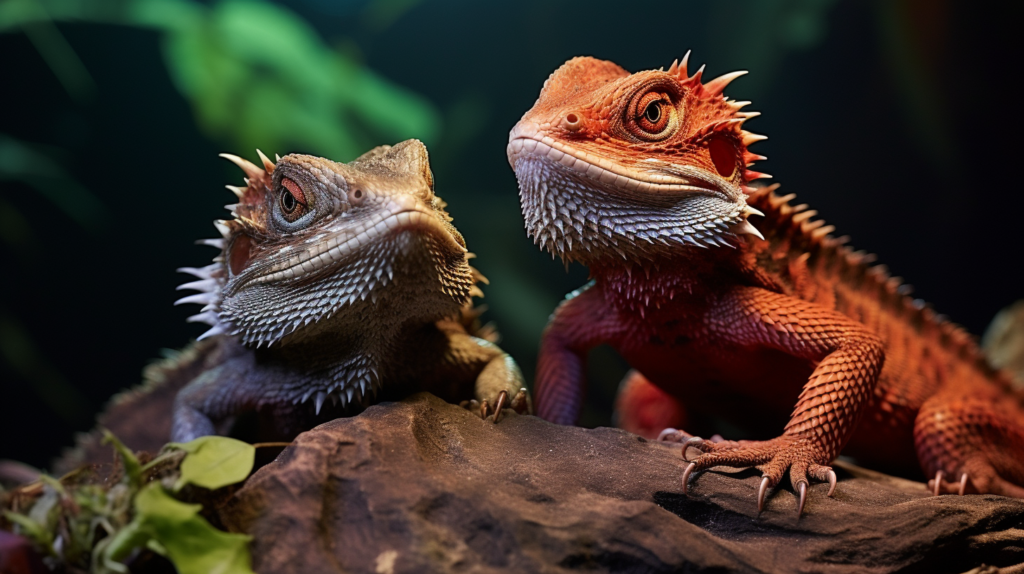Have you ever noticed how a bearded dragon’s eyes seem to follow you around the room, almost like they’re keeping an eye on you? It’s a curious thing, isn’t it?
Many bearded dragon owners wonder if their scaly companions actually recognize them as their caregivers. The answer might surprise you, as there’s more to this question than meets the eye.
Can these reptiles truly form a bond with their owners, or is it simply a matter of learned behavior? Let’s explore the fascinating world of bearded dragon cognition and find out.
Yes, bearded dragons can recognize their owners. They use visual, olfactory, and behavioral cues to distinguish their owners from others. Understanding their body language and vocalization cues is important in interpreting their feelings and intentions.
Bearded Dragon Behavior Towards Owners
Bearded dragons often display distinct behaviors towards their owners, such as seeking attention or exhibiting signs of recognition and trust. Understanding these behaviors requires attentiveness to their body language cues and vocal responses.
When seeking attention, a bearded dragon may approach the enclosure glass or the owner directly, and might even wave its arm in a slow, circular motion. This is a clear body language cue indicating a desire for interaction. Additionally, they may puff out their beard, darken their beard color, or bob their head up and down, all of which are signs of recognition and trust. These behaviors are crucial in understanding the bond between bearded dragons and their owners.
Vocal responses from bearded dragons are another important aspect of their behavior towards their owners. While bearded dragons aren’t capable of vocalizing in the same way as mammals, they do produce sounds such as hissing or puffing when feeling threatened or distressed. However, when they’re comfortable and content, they may emit soft, rhythmic, and repetitive sounds. These vocal responses can be a form of communication and provide insight into the bearded dragon’s emotional state and level of comfort with their owner.
Signs of Recognition in Bearded Dragons
When observing bearded dragons for signs of recognition, pay close attention to their body language cues and vocal responses to determine their level of familiarity and trust. Bearded dragons, like many other animals, communicate their recognition and comfort through a variety of behavioral cues and vocalizations. Understanding these signs can help you build a stronger bond with your pet and ensure their well-being.
Here are some key signs to look for when determining if your bearded dragon recognizes you:
- Body Language Cues: Bearded dragons may show recognition through relaxed body posture, such as a calm and slightly raised head, smooth and un-tensed body, and a willingness to approach or be handled. They may also display recognition by eagerly seeking interaction, such as approaching the tank’s glass when you approach or showing excitement when you enter the room.
- Vocalization Patterns: While bearded dragons aren’t known for vocalizing like some other reptiles, they may still produce soft sounds or even slight head-bobbing movements when they recognize and feel comfortable with their owners. Pay attention to any subtle vocalizations or head movements that occur in response to your presence.
- Eye Contact: Bearded dragons may establish eye contact with their owners as a sign of recognition. They may also follow the owner’s movements with their eyes, showing an awareness and acknowledgment of their presence.
- Relaxed Behavior: Recognizing bearded dragons may exhibit a sense of calmness and relaxation when in the owner’s presence, often basking or lounging comfortably rather than displaying signs of stress or anxiety.
Factors Affecting Recognition Ability
Factors affecting the ability of bearded dragons to recognize their owners include environmental stimuli, previous interactions, and individual differences in temperament and socialization experiences.
Environmental stimuli play a crucial role in a bearded dragon’s recognition ability. These creatures are highly visual and responsive to their surroundings. Factors such as the consistency of interaction with their owners in a particular environment, the presence of other pets, and the layout of the living space can impact a bearded dragon’s recognition of their owner.
Previous interactions also significantly influence a bearded dragon’s ability to recognize their owner. Positive experiences, such as regular handling, positive reinforcement, and gentle socialization, can contribute to the development of recognition and trust. Conversely, negative experiences or lack of interaction may hinder recognition abilities.
Individual differences in temperament and socialization experiences among bearded dragons can affect their recognition ability. Some individuals may naturally be more social and responsive to their owners, while others may be more reserved or cautious. Furthermore, early socialization experiences during the critical developmental stages of a bearded dragon’s life can shape their ability to recognize and respond to their owners.
Bonding and Trust With Bearded Dragons
Bonding and trust with bearded dragons develop through consistent positive interactions, which are essential for fostering a strong and reliable relationship between owners and their reptilian companions. Trust building is a crucial element in developing a meaningful bond with your bearded dragon. By understanding their social behavior and needs, you can effectively build trust and strengthen your relationship.
Here are some tips for bonding and trust building with your bearded dragon:
- Consistent Handling: Regular, gentle handling helps your bearded dragon become accustomed to your presence and touch. This can lead to increased trust and a sense of security.
- Creating a Safe Environment: Providing a secure and comfortable habitat with hiding spots and appropriate temperatures can help your bearded dragon feel safe and reduce stress, contributing to trust building.
- Positive Reinforcement: Using positive reinforcement techniques, such as offering favorite treats or gentle petting, can help in building trust and strengthening your bond over time.
- Respect Their Boundaries: Be observant of your bearded dragon’s body language and respect their boundaries. This helps in establishing trust and shows your respect for their individual preferences.
Understanding the importance of trust building and social interaction with your bearded dragon is vital for creating a harmonious and fulfilling relationship. By implementing these strategies, you can cultivate a strong bond based on trust and mutual respect.
Tips for Strengthening Owner-Bearded Dragon Relationship
To further enhance the relationship between you and your bearded dragon, it’s essential to implement specific strategies that promote trust and understanding, ultimately strengthening the bond between owner and reptile. Two key methods for achieving this are interactive play and positive reinforcement.
| Interactive Play | Positive Reinforcement |
|---|---|
| Engage in regular, gentle handling and interactive play sessions to build trust and familiarity. | Use treats, such as small pieces of fruits or insects, to reward desired behaviors, such as responding to their name or performing a trick. |
| Offer a variety of stimulating toys and objects for your bearded dragon to explore and interact with. | Consistently praise and offer treats when your bearded dragon follows commands or displays friendly behavior. |
| Experiment with different types of play, such as allowing your bearded dragon to chase a small ball or explore a supervised outdoor area. | Be patient and consistent in your reinforcement to reinforce positive behaviors and discourage negative ones. |
Engaging in interactive play with your bearded dragon not only provides mental stimulation but also fosters a deeper connection between you and your pet. Positive reinforcement, through the use of treats and praise, further reinforces desired behaviors and helps your bearded dragon associate you with positive experiences. By incorporating these strategies into your interactions with your bearded dragon, you can strengthen the bond and trust between you, ultimately leading to a more fulfilling relationship.
Frequently Asked Questions
What Are the Best Ways to Train a Bearded Dragon to Recognize Its Owner?
To train a bearded dragon to recognize its owner, use positive reinforcement. Start with short, frequent interactions and slowly increase duration. Watch for behavioral cues like head bobbing and relaxed body language to gauge progress.
Can Bearded Dragons Differentiate Between Different Family Members and Friends?
Bearded dragons can differentiate between family members and friends based on body language cues. Bond-strengthening techniques enhance recognition. Research suggests they respond to individual interactions, indicating recognition of familiar faces.
Do Bearded Dragons Show Any Signs of Distress When They Don’t Recognize Their Owners?
When bearded dragons don’t recognize you, watch for behavioral cues like avoiding interaction or stress marks. They may not cognitively recognize owners but can bond through positive interaction and consistent care.
Can a Bearded Dragon’s Recognition of Its Owner Change Over Time?
Over time, a bearded dragon’s recognition of its owner can change due to behavioral changes and trust building. Long term bonds can strengthen through familiarity cues, allowing for a deeper connection between you and your pet.
Are There Any Specific Behaviors or Body Language Cues That Owners Can Use to Strengthen Their Bond With Their Bearded Dragon?
To build trust and understand body language with your bearded dragon, observe their reactions to your presence, offer regular positive interactions, and respect their personal space. Consistent care and positive reinforcement can strengthen your bond.
Conclusion
In conclusion, bearded dragons are capable of recognizing their owners through their behavior and interactions.
Factors such as regular handling, positive reinforcement, and a calm environment can contribute to the strengthening of this bond.
Understanding the signs of recognition and implementing trust-building techniques can help foster a strong and meaningful relationship between owners and their bearded dragons.
By taking the time to understand and connect with these fascinating creatures, you can create a unique and rewarding bond.


